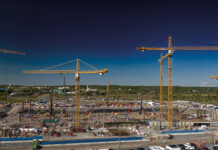The announcement by federal finance minister Bill Morneau that a stronger, longer term commitment was being made to funding infrastructure projects throughout the country was a huge victory for communities across Canada.
The additional $81 billion, which both expands and extends the original infrastructure investment commitment made by the Trudeau government in Budget 2016, focuses on investments in public transit, green and social infrastructure, transportation infrastructure that supports trade.
That compliments the federal investments already announced earlier this year, which focused on municipal priorities for both new and rehabilitation priorities in some of those same industries. In most cases that meant municipalities had to focus funding on shovel-ready projects, mostly significant rehabilitation work, which was in tune with the infrastructure spending priorities set out by the federal government.
“We focused Phase 1 investments on fixing what we have and bringing our existing infrastructure into a state of good repair,” said minister of infrastructure Amarjeet Sohi during a recent interview with ReNew Canada. “Phase 1 filled a need that was not filled for many, many years. That infrastructure backlog in repairs and rehabilitation was growing.”
The new funding priorities will clearly have the green lens focused on them, ensuring that emissions and resilience are strongly considered. Minister Sohi mentioned that more resilience towards climate change stands as one of the three lenses applied to infrastructure investment, alongside projects that grow the economy and projects that make communities more welcome and inclusive. Investments in energy transmission, renewable energy, cycling and public transit are all priority areas with green impacts, with environment and sustainable considerations woven into project funding.
Establishing the Canada Infrastructure Bank
The update provided by minister Morneau also represented the formal introduction of the Canada Infrastructure Bank, a $35 billion investment that will be matched 4:1 or 5:1 by private sector investment.
“This will further mobilize private capital to build more infrastructure on top of what we can do in our traditional ways,” said minister Sohi. “We’re very optimistic about what we can do with the creation of the infrastructure bank and how we make a very important additional tool available to our provinces and municipalities to mobilize private sector capital including pension funds.”
Sohi recognized that, despite record investments from all three levels of government, there is still not enough money to meet the current new and rehabilitated infrastructure needs across Canada.
The new bank is designed to be an option for provincial and municipal governments in need of a funding source for significant infrastructure needs. This will not detract from funding models already in existence, instead providing an alternative when the need appears.
“We will not be imposing requirements on any municipality. Using the infrastructure bank as a tool is an option for municipalities and we want to create the right incentives for them to do so. We definitely want to make sure that they see the benefit and that they use this as willing partners.”
Sohi suggested that the bank will also act as a resource for municipalities that can provide advice and assistance on best procurement practices, as well as working with them on how to structure deals that protect the public interest.















